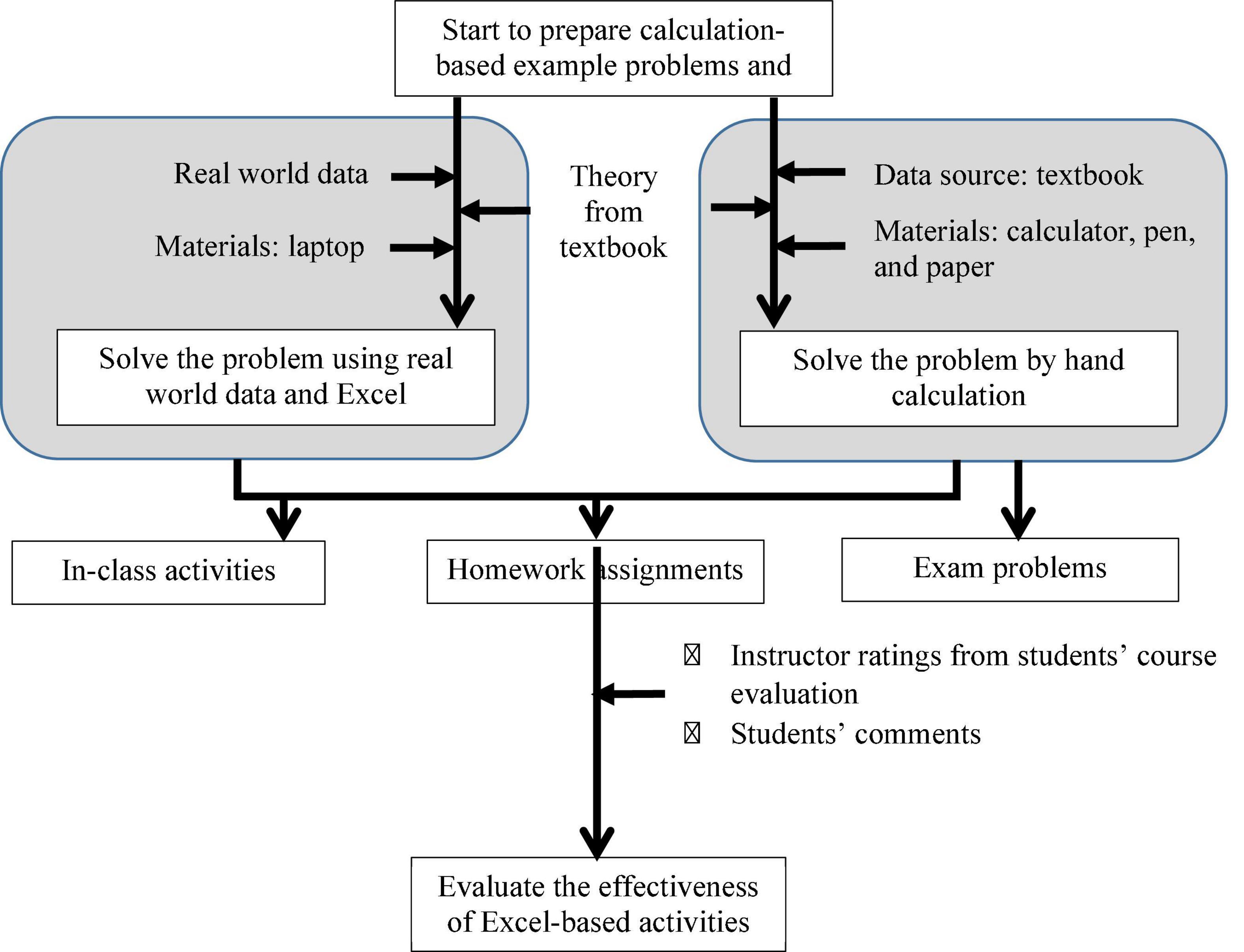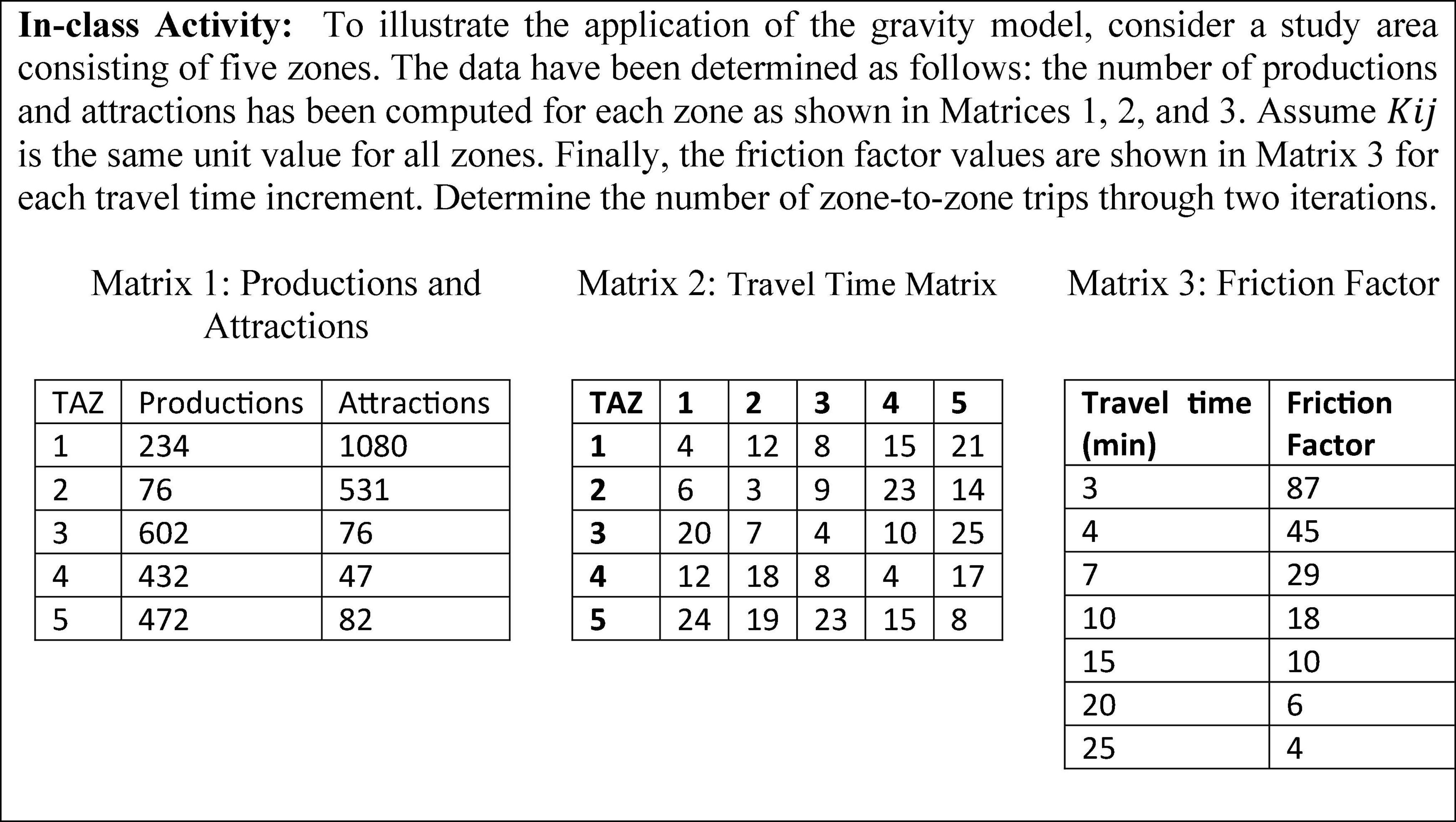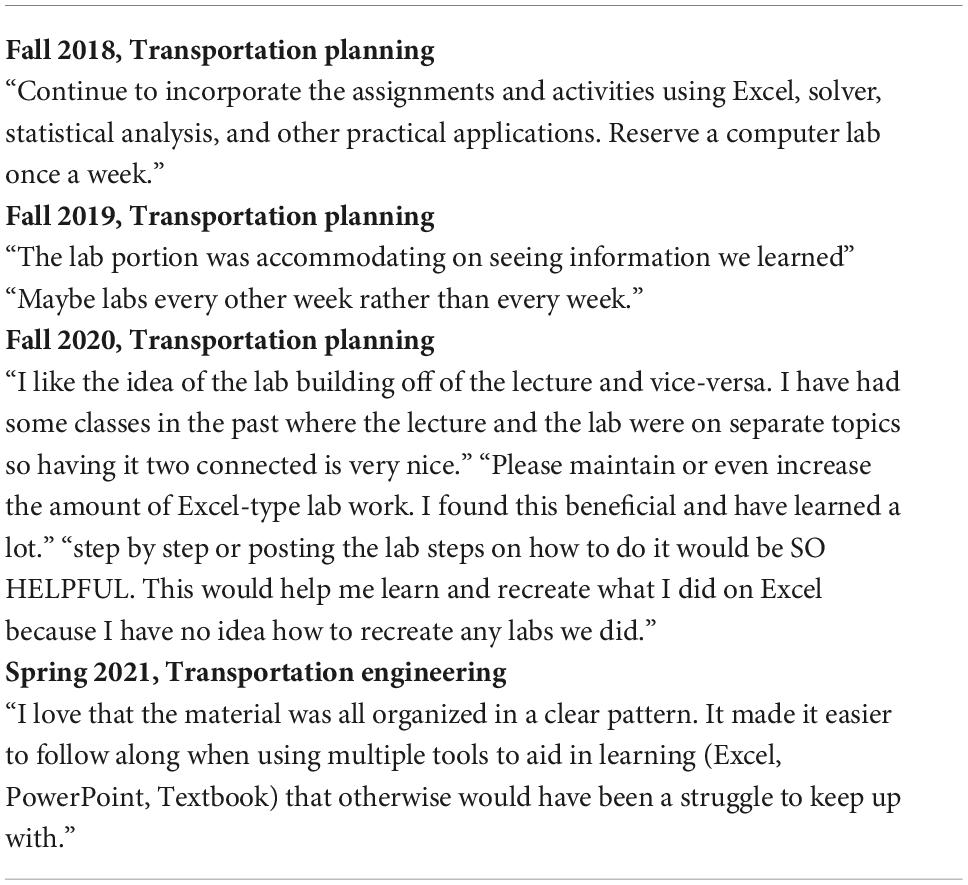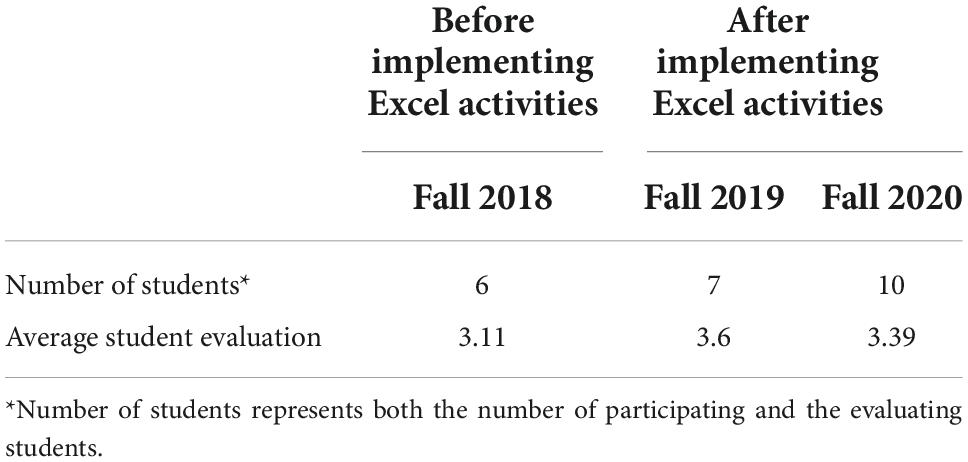Effectiveness of in-class excel-based active learning activities for transportation engineering courses
- Department of Civil and Mechanical Engineering, Purdue University Fort Wayne, Fort Wayne, IN, United States
Recently, transportation engineering industry members showed concern that students lacked the skills to solve real-world engineering problems using spreadsheet data analysis. In response to the circumstances shown by industry members, this study investigated how to engage students in a better way by incorporating spreadsheet analysis during class and helping them learn the course topics. Helping students link theoretical knowledge to real-world problems can be a challenge. In this effort, in-class activities and worksheets were redesigned to integrate with Excel to solve example problems using built-in tools, including cell references, equations, data analysis tool pack, solver tool, conditional formatting, charts, etc. The effectiveness of this technique was investigated using students’ evaluations of the course, enrollment data, and students’ comments. Based on the data of those criteria, it is evident that spreadsheet activities may increase student learning.
Background
Industrial Advisory Board (IAB) members at the study university play a critical role in improving an engineering program by guiding the program’s direction and ensuring the needs of their workforce are met. Encouraged by accreditation standards, many departments conduct an annual survey to receive feedback from IAB members on improving their program so that students are ready to work in the industry upon graduation. Recently, civil engineering IAB members specialized in transportation engineering showed concern that is graduating students lack the spreadsheet skills needed for solving real-world engineering problems. In response to this concern, this study investigated how to help students learn Excel to solve transportation engineering problems as a part of the lecture.
The primary objective of this study is to help students learn Excel spreadsheets for solving transportation engineering problems. The in-class worksheets were reshaped to achieve the objective, incorporating Excel spreadsheets to solve example problems and hand calculations. For the Excel activity, students are provided the data in an Excel spreadsheet. Students use that data to solve the same worksheet problem using built-in Excel tools, including cell references, equations, data analysis tool pack, solver tool, conditional formatting, charts, etc.
Literature review
Previous studies suggested that active learning is a standard method to foster students learning in engineering (Nickels, 2000; Douglas and Chiu, 2009; McCloskey and Bussom, 2013; Anitha and Rao, 2014; Ssemakula et al., 2018). Different active learning techniques include think-pare-share (TPS), group assignments, reciprocal questioning, the pause procedure, the muddiest point technique, the devil’s advocate approach, group discussions, formative quizzes, and lecture summaries, etc. (Nickels, 2000; Douglas and Chiu, 2009; McCloskey and Bussom, 2013; Anitha and Rao, 2014; Ssemakula et al., 2018). Among the techniques, TPS is the most used technique in many engineering classes where solving example problems are a vital component of the lecture (Nickels, 2000). According to this technique, a specifiv topic is presented to the class, and students take notes. Then, an example problem related to the covered topic is ready to be solved. Sometimes, students are provided a handout known as an in-class worksheet listing the example problems that will be solved during class.
McCloskey and Bussom (2013) studied active learning in the business curriculum using an Excel spreadsheet. This study reviews how Excel spreadsheet was used in business classes to learn problem-solving techniques and the active use of spreadsheets. Several previous studies, from science to engineering to political science, investigated how to engage students better (Smith et al., 2005; Heller, 2010; Marshall and Nykamp, 2010; Peters and Beeson, 2010; Popkess and McDaniel, 2011). McCloskey and Bussom (2011) studied students’ engagement in the learning process using an Excel spreadsheet. Uddin et al. (2017) learned how to use Excel to teach physics. In this study, Excel was used as a simulating tool. Several aspects of Excel were demonstrated in this article. All these studies suggest that Excel can be an excellent tool to enhance student learning. To the author’s knowledge, no studies were found investigating the effectiveness of Excel on student learning in engineering classes. This study investigated student learning in civil engineering classes, especially in the transportation area.
Several papers were studied related to how to use Excel spreadsheets for solving engineering problems and financial analysis efficiently (Nickels, 2000; Douglas and Chiu, 2009; McCloskey and Bussom, 2013; Anitha and Rao, 2014). Microsoft Excel has many tools, including Visual Basic for Applications (VBA). VBA is developed explicitly for Excel and is currently used for many applications, including financial analysis, engineering problems, data management, etc. Sprego (Spreadsheet Lego) is a simplified version of VBA that helps to solve advanced engineering problems (Nickels, 2000; Douglas and Chiu, 2009; McCloskey and Bussom, 2013). McCloskey and Bussom (2013) conducted a case study on the effectiveness of teaching spreadsheet management using Sprego. Results indicated that Sprego could be used for solving advanced problems easily efficiently. Also, S. Abramovich studied students’ ideas in the digital era (Anitha and Rao, 2014). The primary projective of this study was to contribute to Technology-immune Technology-enabled (TITE) mathematics education research efforts by using Wolfram Alpha and Microsoft Excel spreadsheet.
Methodology
The primary requirement to execute the activities related to Excel is that students need a computer to work on the activities during class. If the classes are taught in a traditional classroom, students must to bring their laptops, or the course must be taught in a computer lab. For this study, the methodology has two main steps: (1) Develop the worksheets; (2) Evaluate the effectiveness of the learning strategy. The overall methodology can be seen in Figure 1.
Students are provided with handouts and in-class worksheets at the beginning of a typical lecture class. In-class worksheets include the description of example problems, and handouts provide the tables, figures, and equations needed to solve the problems. The class starts with discussing a topic; then, students try to solve a problem provided in the in-class worksheet. After that, the instructor solves the problem with the students’ help, followed by creating an excel spreadsheet to solve the same problem using built-in Excel tools. The spreadsheet should produce the outputs by only changing the inputs. At the end of the lecture, students must submit their in-class work, including a worksheet and an Excel spreadsheet. First, students are learn how to use Excel tools to solve engineering problems. Students’ evaluation shows that students enjoy solving the problems using Excel spreadsheets, and most importantly, they mentioned that it helped them understand the problem better. Also, it was noticed that Excel activities help energize students to be active in the middle of a class. Students need to bring their laptops to class. A Wireless internet connection is also beneficial for downloading the necessary files for the class.
In this study, two courses were considered, transportation planning and transportation engineering. Both courses are very similar in terms of course assessment. The following section discusses only the transportation planning course as an example. In the analysis section, the data from both courses are presented. The courses will be referred to as Transportation Planning and Transportation Engineering for discussion purposes. Both are junior/senior-level courses, respectively.
CE 401 transportation planning
This course was a small, technical elective class taught at a public university in the Midwest. As the prerequisite of this course is a junior-level transportation engineering course only senior-level students usually take this course, and is offered once a year in the fall semester. From 2018 to 2020, the enrollment was 6, 7, and 10 students, respectively. The course assessment included two exams (40%), weekly quizzes (5%), homework assignments (25%), course project (20%), and class participation (10%). Class participation comes from the in-class worksheets, and Excel spreadsheet analysis is a significant part of the in-class worksheets.
The CE 401 course structure included two 1 h and 20-min class periods per week and involved some active learning exercises in the form of calculation-based problems in every class. During a typical class, students learn a topic through lectures and then work on a relevant calculation-based example problem. Usually, the problems are iteration-based, which means the answer from each iteration will be close to the solution. As the number of iterations increases, the accuracy of final the answer increases. Because of the nature of the problems, it was observed that an Excel spreadsheet could be of great help in getting the final answer quickly and easily. In-class activities included hand calculations and then developing an Excel spreadsheet to get the same answer from hand calculation. At the end of the lecture, students must submit their in-class work. The whole in-class activities were graded out of 10%.
The instructor created the in-class activities involving Excel spreadsheet using real-world data on local transportation networks obtained from different transportation agencies, including city governments and metropolitan planning organizations. The activities were like the standard end-of-chapter problems regarding the steps and equations required. As the data used for the activities are on the local transportation network, students can relate to the problems better, as evidenced by the student’s comments from the student course evaluations. After the lecture, the solution to the Excel activities was posted on the course website.
Excel-based problems are also a significant part of homework assignments. Weekly homework assignments comprised of 3–5 homework problems. 1–3 problems were created by the instructor that requires an Excel spreadsheet, and those are very similar to the in-class problems.
In the exams, 70% of the exam grades are open books, and the remaining are closed books. The open book part consists of calculation-based problems like homework problems, but in a short version so that students can solve them during exam without an Excel spreadsheet. Students are not allowed to bring their laptops during exams to solve the problems, but they can use other course materials, including homework assignments, handouts, books, and lecture slides.
In transportation planning courses, sometimes example problems require several iterations to get the final answer. For instance, sample example problems can be seen in Figure 2. The solution to the problems can be seen in Table 1. In the solution matrix (see Table 1), 25 values (5 rows × 5 columns) needed to be calculated. The same set of equations is used to get each value of all 25. Using a spreadsheet, the solution can be obtained very quickly and easily.
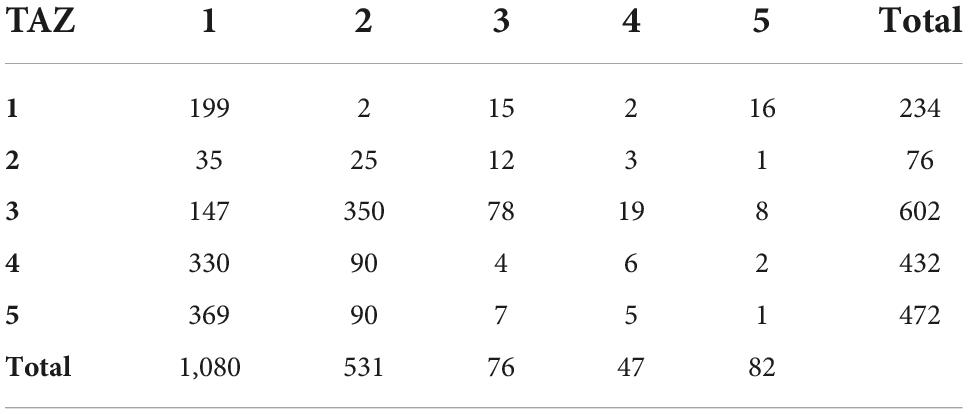
Table 1. Solution to the in-class activity shown in Figure 2.
The effectiveness of using Excel spreadsheets was divided into two categories: (1) instructor observations from a transportation planning course and (2) Before-after analysis of student data. These two categories are discussed and supported by the data below.
Instructor observations
The incorporation of Excel activities was seen to serve two benefits. First, students practiced learning to solve real-world problems from hands-on experience. Second, students expressed enthusiasm for working on Excel activities, as evidenced by in-class discussion, in-class engagement, and students’ course evaluations, which will be discussed later.
Overall, creating Excel-based in-class activities appeared to motivate students. The instructor plans to continue this active learning technique in future semesters.
Before-after analysis of student data
Two primary indicators were investigated to assess the effectiveness of incorporating Excel activities, including (1) student comments and (2) overall instructor ratings. In the following subsections, these two indicators were discussed.
Student comments
Every semester, the university conducts an anonymous student course evaluation for every course in the final quarter of the semester. After submitting the final grades, the instructor receives the results, so the survey respons cannot impact grades. In the course evaluation, students rate their instructor by answering 11 questions and writing comments on four topics. One of the four topics was “Please identify and explain aspects of the course that you encourage the instructor to maintain in the future.” For this study, the student’s responses were investigated to identify those related to the Excel activities. Table 2 shows the quantitative summary of the comments for CE 401. In the fall of 2018, Excel activities were introduced in five lectures on CE 401 Transportation Planning. From the student’s course evaluation, one student suggested adding more Excel activities in future semesters. The comment is: “Continue to incorporate the assignments and activities using Excel, solver, statistical analysis, and other practical applications. Reserve a computer lab once a week.” Based on this comment, the instructor incorporated Excel activities once a week (50% of total meetings) for Fall 2019. In fall of 2019, two comments were received, and both were related to Excel activities. One favors of continuing Excel activity, and the other suggested having these activities every other week. In 2020, four comments were received, three of them were related to Excel activities, and all were in great favor of continuing Excel activities. The comments can be seen in Table 3. In 2021, Excel activities were also introduced in the CE 301 Transportation Engineering course. Only one comment on Excel activities was received (see Table 2). Overall, students liked the idea of the Excel activities building off the lecture and found this extremely helpful in enhancing their learning. As per the students’ suggestion, the instructor also realizes that a handout providing step by step explanation of using an Excel spreadsheet to solve the problem would be helpful for future reference.
Overall instructor ratings
Overall instructor ratings was investigated to assess the effect of incorporating Excel activities from 2018 to 2021 (Appendix A1). Tables 4, 5 present two courses’ enrollment data and overall student evaluation from 2018 to 2021. In the fall of 2018, the instructor started to teach CE 401 and incorporated Excel activities in only five lectures. Students’ course evaluations may also indicate their effectiveness. Students’ evaluations of CE 401 increased from 3.11/4.0 in 2018 to 3.6/4.0 (ratings on a Likert scale of Poor = 1 to Excellent = 4) in 2019, which may indicate the effectiveness of incorporating Excel activities during lectures. Similarly, for CE 301, student evaluations also increased from 2.89 to 3.9. It is important to note that no other major changes were made in instructing the course except the incorporation of Excel activities.
Conclusion
In this study, an active learning technique using Excel spreadsheet analysis was investigated in two transportation engineering courses to determine whether it fosters students’ learning. A worksheet was developed by listing calculation-based example problems for every lecture. Students are assigned to work on those example problems by hand calculation during class time. Then, students created an Excel spreadsheet to solve the same problem using different built-in tools, including solver, cell referencing, data analysis, conditional formatting, charts, built-in functions, etc. The effectiveness of this technique was investigated using students’ course evaluations and comments. Results concluded that the technique was very effective in fostering students learning.
Data availability statement
The original contributions presented in this study are included in the article/supplementary material, further inquiries can be directed to the corresponding author.
Ethics statement
The studies involving human participants were reviewed and approved by Purdue IRB. Written informed consent for participation was not required for this study in accordance with the national legislation and the institutional requirements.
Author contributions
The author confirms being the sole contributor of this work and has approved it for publication.
Conflict of interest
The author declares that the research was conducted in the absence of any commercial or financial relationships that could be construed as a potential conflict of interest.
Publisher’s note
All claims expressed in this article are solely those of the authors and do not necessarily represent those of their affiliated organizations, or those of the publisher, the editors and the reviewers. Any product that may be evaluated in this article, or claim that may be made by its manufacturer, is not guaranteed or endorsed by the publisher.
References
Anitha, H. M., and Rao, A. N. (2014). Active learining techniques in engineering education. Int. J. Res. Eng. Technol. 3, 462–465. doi: 10.15623/ijret.2014.0311079
Douglas, E. P., and Chiu, C. C. (2009). “Use of guided inquiry as an active lea,” in Proceedings of the Research in Engineering Education Symposium, (Palm Cove: QID), 2, 1–6.
Heller, R. S., Kim D., Belinda H., and Cheryl B. (2010). “Student and Faculty Perceptions of Engagement in Engineering,” J. Eng. Educ. 99, 253–262. doi: 10.1002/j.2168-9830.2010.tb01060.x
Marshall, L. L., and Nykamp, D. (2010). Active Learning Assignments to Integrate Basic Science and Clinical Course Material. Am. J. Pharmaceut. Educ. 74:119. doi: 10.5688/aj7407119
McCloskey, D. W., and Bussom, L. (2013). Active Learning and Student Engagement in the Business Curriculum: Excel Can Be the Answer. Int. J. Learn. High. Educ. 9, 1–12.
McCloskey, D. W., and Bussom, L. B. (2011). “Using Excel in Business Curricula: An Opportunity to Combine Student Engagement with Active Learning,” in Proceedings of the Northeast Business & Economics Association, (Philadelphia, Pennsylvania), 59–62.
Nickels, K. (2000). “Do’s and don’ts of introducing active learning techniques,” in Proceedings, ASEE Annual Conference, (Washington, DC: American Society of Engineering Education).
Peters, R., and Beeson, M. (2010). Reducing the Gap between Skills Sought by Employers and Developed in Education. Politic. Sci. Politic. 43, 773–777. doi: 10.1017/S104909651000123X
Popkess, A. M., and McDaniel, A. (2011). Are Nursing Students Engaged in Learning? Nurs. Educ. Perspect. 32, 89–94. doi: 10.5480/1536-5026-32.2.89
Smith, K. A., Sheppard, S. D., Johnson, D. W., and Johnson, R. T. (2005). Pedagogies of Engagement: Classroom-Based Practices. J. Eng. Educ. 94, 87–102. doi: 10.1002/j.2168-9830.2005.tb00831.x
Ssemakula, M., Ayoobi, M., and Djuric, A. (2018). “ALERT: An Implementation,” in Proceedings of the 2018 Conference for Industry and Education Collaboration, (San Antonio, TX: ASEE PEER Document Repository).
Uddin, Z., Ahsanuddin, M., and Khan, D. A. (2017). Teaching physics using Microsoft Excel. Phys. Educ. 52:053001. doi: 10.1088/1361-6552/aa7919
Appendix
| # | Question | Fall 2018 | Fall 2019 | Fall 2020 | Spring 2019 | Spring 2020 | Spring 2021 |
| 2.3 | Class content | 3.2 | 3.6 | 3.25 | 3.27 | 2.88 | 3.7 |
| 2.4 | The textbook | 2 | 3.6 | 3 | 3.18 | 2.63 | 3.6 |
| 2.5 | Film, other aides and lab facilities | 2.6 | 3.6 | 3.5 | 3.36 | 2.86 | 3.8 |
| 2.6 | Assignments related to course goals | 3.2 | 3.8 | 3.5 | 3.18 | 2.75 | 3.6 |
| 2.7 | Exams measured my understanding | 3.2 | 3.6 | 3.38 | 3.09 | 2.63 | 3.6 |
| 2.8 | Course overall | 3.2 | 3.8 | 3.43 | 3.18 | 3.13 | 3.8 |
| 3.2 | Instructor’s knowledge of subject | 3 | 3.8 | 3.63 | 2.73 | 3.13 | 3.7 |
| 3.3 | Instructor’s ability to present material | 3.4 | 3.6 | 3.63 | 3.45 | 3 | 3.7 |
| 3.4 | Instructor’s concern for students | 3.6 | 3.6 | 3.38 | 3.55 | 3.13 | 3.5 |
| 3.5 | Instructor’s enthusiasm for subject | 3.4 | 3.4 | 3.25 | 3.27 | 2.63 | 3.9 |
| 3.6 | Instructor overall | 3.4 | 3.2 | 3.38 | 3.27 | 3 | 3.5 |
| Average | 3.11 | 3.6 | 3.39 | 3.23 | 2.89 | 3.41 | |
Keywords: engineering, active learning, transportation, excel, spreadsheet
Citation: Saha P (2022) Effectiveness of in-class excel-based active learning activities for transportation engineering courses. Front. Educ. 7:879174. doi: 10.3389/feduc.2022.879174
Received: 18 February 2022; Accepted: 13 June 2022;
Published: 15 December 2022.
Edited by:
Antonio Bevilacqua, University of Foggia, ItalyReviewed by:
Antonio Bevilacqua, University of Foggia, ItalyMária Csernoch, University of Debrecen, Hungary
Copyright © 2022 Saha. This is an open-access article distributed under the terms of the Creative Commons Attribution License (CC BY). The use, distribution or reproduction in other forums is permitted, provided the original author(s) and the copyright owner(s) are credited and that the original publication in this journal is cited, in accordance with accepted academic practice. No use, distribution or reproduction is permitted which does not comply with these terms.
*Correspondence: Promothes Saha, sahap@pfw.edu
 Promothes Saha
Promothes Saha